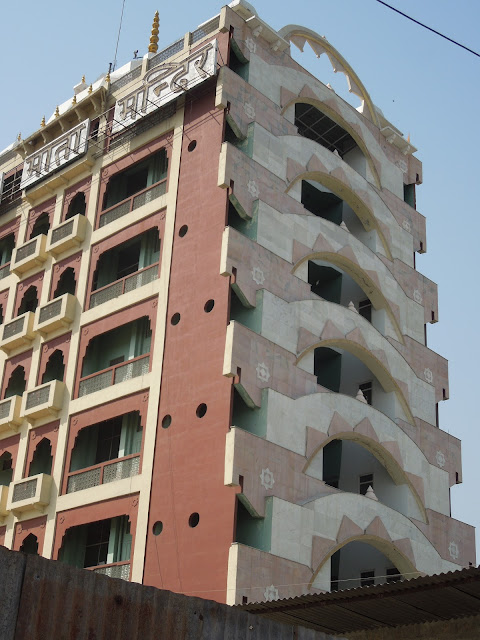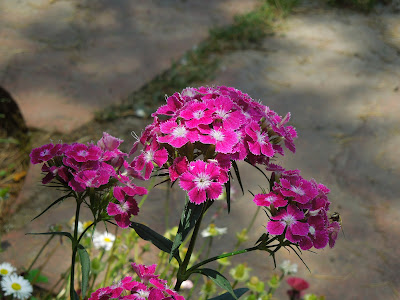Hello everyone,
Today, I will tell you about my visit to the pink city of India, Jaipur. I visited Jaipur on 16th June 2012. Entering Jaipur I visited the Jaigarh Quilla which was built by Sawai Jai Singh III. The fort was named after king Jaisingh as Jaigarh quilla. This palace was built to protect already existing palace of Amber known as Amber palace.
 |
| Amber Palace |
The palace of Jaigarh was a real masterpiece and an example of art and culture that prevailed in those times in royal families. One thing that I noted there at the palace was still prevailing dominance of the present king of Jaipur i.e. Sawai Padmanabh Singh. Till now the fort of Jaigarh hosts the flag of the royal family and not the national flag, as you can see in the picture below.
 |
| Flag of the royal family |
The water needs of the fort were fulfilled by rain water harvesting. The water collected in the huge tanks of fort could be used by 10000 people for 2 years, such a big capacity.
Water was actually collected through the huge canal type structures that were built inside the fort and then they traveled the whole distance thus moving through some narrow paths and thus cleaning of water takes place. After that it is stored in a temporary tank for some time so that water is cleared by sedimentation, than again it is traveled through a narrow sloppy path to the collector tank that is used to store the water for drinking purpose.
 |
| A canal type structure of the fort to collect rain water |
 |
| Water is again traveled through this narrow path to the tank and thus pure drinking water is collected in the tank |
After this the next interesting thing in the fort was the Jaivana Cannon. It is known to be the largest cannon of the world. It is known that it was fired once only and was never used any of the battles. When it was fired it used a 50 kilograms ball and was fired 35 km away from the spot. The explosion was so fierce that it almost deaf-ed the people who fired the cannon. The cannon weighed 2.5 tonnes completely and has a very good carving of tress, an elephant scroll and a pair of birds (ducks).
 |
| Jaivana cannon in Jaigarh |
Then came the Subhat Niwas of the fort. It was the assembly hall for the warriors. The hall shown below is the main courtroom of the fort. Below where a bedding is placed was the place for the King to sit in the room and behind the window was the place for the queen to sit.
 |
| Subhat Niwas courtroom |
After subhat niwas there were different rooms for the courtiers and king where they completed their daily chores.
 |
| Food room for the king and his courtiers |
 |
| Royal kitchen of the fort |
Then came the place where the armory of the fort was built. The thing that I liked the most was the preparation room of cannon. It consisted of a outer covering of the cannon in which iron and other materials are filled in liquid form and then they are dried to make the metal which is shaped in the form of cannon, and thus the cannons are prepared.
 |
| The cannon room |
After the palace I visited the famous place of Jaipur which is known as Chowk Ki Dhani. It is the one and only place there which shows the complete culture of Rajasthan. Everything present there depicts the typical Rajasthani culture, even the dresses of people there are in Rajasthani form as is shown below.
 |
| Rajasthani dress |
There are various small-small museum that depicts the culture and tradition of Rajasthan. Various types of utensils and other cultural things were displayed in these museums which were used by people to prepare food and other kind of things there.
Different types of utensils, big pots and patilaas are shown in these pictures. These are used in villages of Rajasthan even today to prepare food.
There were also the models of typical houses that are present in Rajasthan areas other than the desert area. The picture below shows one such house.
 |
| A Rajasthani House |
 |
| A house of desert area |
Then it was some time for a Rajasthani dance performance. Chowk Ki Dhani gave me a privilege to see and examine a traditional folk dance of Rajasthan. The dance was actually a masterpiece of art and culture prevailing there. You can yourself have a look at the dance in the video below.
After this I did a camel ride there. It was truly a new experience for me sitting on a camel. Now it was time for food. The food was completely prepared and served in the Rajasthani style. It was served in Rajasthani Thalis and had a large variety of dishes such as daal mot, kadi, damaloo, Maalpua etc. It was served in exactly Rajasthani style and was very tasty. Truly I became the fan of Rajasthani food.
That's all for the day. Now in my next post I will tell you more about my visit to Jaipur.
Thank You






































